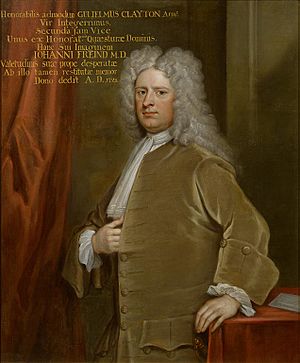William Clayton, 1st Baron Sundon facts for kids
William Clayton, 1st Baron Sundon (born 1671 – died 29 April 1752) was an important British government official and politician. He lived at Sundon Hall in Sundon, Bedfordshire. William Clayton worked for the Treasury, which manages the government's money. He was also a Member of Parliament (MP) in the British House of Commons for many years, from 1716 until he passed away in 1752.
Contents
Early Life and Family
William Clayton was born in 1671 and was baptized on November 9th of that year. He was the oldest son of William Clayton and Ann Haske, who were from Newmarket, Suffolk.
Before 1714, William Clayton married a woman named Charlotte. Her father, John Dyve, worked for the Privy Council, which was a group of advisors to the King.
William Clayton's Career in Government
William Clayton started his career in government in 1688. He worked in the Exchequer, which was like the country's finance department. By 1714, he was a deputy auditor, helping to check government accounts.
Working with Important Figures
William Clayton also managed the estates of the Duke of Marlborough when the Duke was away from the country. When King George I came to the throne, William's wife, Charlotte, got a special job. She became a "woman of the bedchamber" for the Princess of Wales, thanks to the Duchess of Marlborough.
In 1715, the Prince and Princess tried to get William Clayton a job as secretary to the Treasury. They were not successful, but they did help him become the paymaster for the King's private pensions. This meant he handled payments for the King's personal expenses.
Becoming a Member of Parliament
In 1716, William Clayton bought the Sundon estates. He was then elected to Parliament as the representative for Woodstock. He won this election without anyone running against him, thanks to the Duke of Marlborough.
In 1718, he became a Lord of the Treasury. This was a high-ranking position where he helped manage the country's money. However, he lost this job in 1720 when the Whig political party reunited.
Challenges and New Roles
William Clayton was chosen to be part of the South Sea committee in the House of Commons. He spoke against some of the government's plans to fix public finances in 1721.
In the 1722 election, he lost his seat in Woodstock. But he was elected as an MP for St Albans. The Duchess of Marlborough supported him in this election. Around this time, the Duke of Marlborough was very ill, and William Clayton was one of the people chosen to manage his affairs after his death.
In Parliament, William Clayton sometimes disagreed with the government. For example, he spoke against a bill to tax Roman Catholics in 1723. In 1725, he became the auditor general for the Prince of Wales, which meant he oversaw the Prince's finances.
Later Political Life
When George II became King, William Clayton was reappointed as a Lord of the Treasury. This was partly because his wife had a strong connection to the Queen. In the 1727 election, he was elected without opposition as the MP for Westminster. He supported the government in Parliament during this time.
He was elected again for Westminster in 1734. After this, he focused mainly on his local area. On June 2, 1735, he was given the title of Baron Sundon. This made him a peer, a member of the nobility, in Ireland.
In the 1741 election, he faced a tough contest in Westminster. There was even a riot because the person in charge of the election closed the voting too early. William Clayton had to be rescued by guards! The House of Commons later said this election was not valid. Around this time, William's wife, Charlotte, passed away after struggling with mental health issues since the Queen's death.
After the government changed, William Clayton lost his job at the Treasury. However, he was given a new seat in Parliament for Plympton Erle in 1742. In the 1747 election, he was elected for St Mawes, another government-supported seat.
Death and Legacy
William Clayton died on April 29, 1752. He did not have any children. Because of this, his title of Baron Sundon ended when he died. Sundon Hall, his home, was inherited by his four nieces, who later sold the property.
Images for kids



